Having inadvertently resuscitated this entire debate by my initial response to Charlie's post, I felt a duty to clarify whatever facts I could. I want to note up front that I have zero skin in this game; I love the way the hole plays with both tiers cut as green.
The only fact I initially knew--that is, until I just did some additional research in various online archives (newspaper and otherwise)--was the 1925 Banks quotation reproduced in the "Golf at Yale" book (also available at the authors' website:
https://webspace.yale.edu/Yale-golf-history/index.htm). That quotation comes from a lengthy preview he wrote about the course for the August 28, 1925 issue of the
Yale Alumni Weekly. Banks's complete description (parts of which are ellipsized in the "Golf at Yale" reproduction) reads as follows: "This hole has its original on the Biarritz course at the famous watering hole in France of the same name. This is the second of the short holes and is planned for a single shot with the driver. There is a 163 yard carry from the back tee. The green proper is behind a deep trench in the approach. The approach is about the same size as the green itself and is bunkered heavily on both right and left with water jutting in on the right front. The fairway is the lake. The tees are elevated above the lake. The green is heavily battered at the back and right and the whole psychology of the hole is to let out to the limit. The distance, however, is not as great as it seems, due to the water, and a moderate strike with care is safer than a slam. Correct play for this green is to carry to the near edge of the groove or trench and come up on the green with a roll. The disappearance and reappearance of the ball in the groove adds to the interest of the play. The carry for this play is 190 yards from the back tee. This type of hole is well set up on the Creek Course where the tide plays a part in the hazard."
Note in particular the last sentence, alluding to the Biarritz hole at the "Creek Course," which I assume is the Creek Club on Long Island. In going through the earlier GCA threads alluding to Banks's description, I noticed that the Creek sentence is omitted. To me, it's significant because, as Tom Paul noted in the 2009 "Biarritz Conundrum" thread, the Creek did not begin mowing the front tier of its Biarritz as green until late in the 20th century.
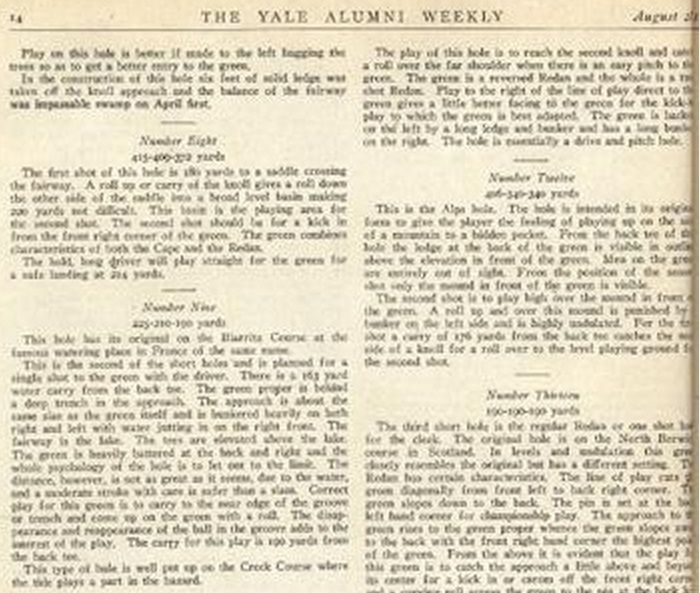
I quickly learned from Pat and others that Scott Ramsay, Yale's magnificent current superintendent, discovered a layer of charcoal, which was otherwise found only under the green surfaces at Yale, beneath the front tier. When I learned that fact, I hypothesized (privately to Pat and publicly in a follow-up post in this thread) that the two (i.e., Banks's words and Ramsay's discovery) were not necessarily mutually exclusive. That is, perhaps the architect's intent was for the front tier to play as approach, while the people in charge of construction built/cut/maintained it as green. We know where things led from there. Although I do not purport to have a definitive answer either way, I will note that, as a logical matter, the presence of charcoal beneath the front tier does not foreclose the possibility that it was designed as approach, not green. Instead, it allows the inference that someone foresaw that playing the front as approach would make reaching the green at the back tier prohibitively difficult, and thus installed the charcoal base to account for the contingency that the front might in fact need to be built/cut/maintained as green.
The newspaper archives shed some, but again no definitive, light on the situation, as most of the descriptions are (largely verbatim) versions of Banks's description. To me, the most illuminating find is in the main
Yale Alumni Weekly article in which Banks's description appears, where the author notes, as far as I can tell (the image quality is poor), that "no pity for misplay was exhibit in laying out this hole, unless one excepts the fact that the approach to the hole is smoother and longer than usual." I also found the picture and description from the September 30, 1925 "Pictorial Supplement" in the
Yale Daily News to be helpful. Note as well that Anthony Pioppi, the President of the Seth Raynor Society and, among other things, the subject of a "Feature Interview" with Ran here on GCA, has an entire blog post on his site devoted to his discovery of the Banks-like description in the
Hartford Courant (second entry below) and its effect on his belief as to the mysterious front tier (
http://anthonypioppi.blogspot.com/2010/06/yales-biarritz-green.html). I also see that Anthony was also the one to start the 2007 "Reassessing Yale's Biarritz Green" thread here on GCA (
http://www.golfclubatlas.com/forum/index.php/topic,32118.0.html).
Notably, the date of the
Hartford Courant article Anthony cites--August 16, 1925--suggests that Banks's comments in the August 28, 1925 version of the Yale Alumni Weekly were made either after or during, but not before, the ninth hole was built, as the article features a picture of the ninth hole.
I hope the below excerpts are at least somewhat helpful.
August 9, 1925: An un-bylined article in the
New York Times notes that "[t]he finishing touches are being put on the course this Summer by a small band of men, and it is expected that by October of this year the entire course will be playable."
August 16, 1925: An un-bylined article in the
Hartford Courant includes a description of the ninth hole. Note that the article also includes a large picture of the ninth hole, but, despite paying to access the article, the resolution of the picture is so poor as to make it useless. For those having trouble reading the text excerpt, the description, which begins in the third full paragraph on the left-hand column, reads: "The ninth hole is over the northwestern end of the Griest pond and has its original on the Biarritz course in France. The green proper is behind a deep groove in the approach which is of about the same area as the green. The approach is bunkered heavily on the right and left and the fairway is the lake. This hole is one of the most interesting of the course and is deceptive because of the full water play, although the hole is not a long one."
 August 28, 1925
August 28, 1925: An un-bylined article in the
Yale Alumni Weekly includes the hole-by-hole descriptions, including that of the ninth hole posted above, now attributed to Charles Banks. In a cruel ironic twist, the concluding paragraph of the article, immediately after the final-hole description, begins by noting that "because of the re-seeding of the greens and fairways during the past few weeks, undergraduates will not be permitted to play the course during the coming fall season." The article also includes a separate description of the ninth hole before the formal hole-by-hole descriptions begin. That separate description, again to the best of my ability to make it out, notes that "the ninth hole presents a water hazard calculated to daunt any but steady golfing nerves. The play is directly across Greist Pond. . . . The water carry is 163 yards, and across it the ground rises from the shore of the pond to a fair elevation on which the green is set. No pity for misplay was exhibited in laying out this hole, unless one excepts the fact that the approach to the hole is smoother and longer than usual." The last sentence appears to provide some resolution to the debate--allowing both sides to have their cake. The article also includes this side view of the ninth green from the first fairway; given the vantage, little can be made out.
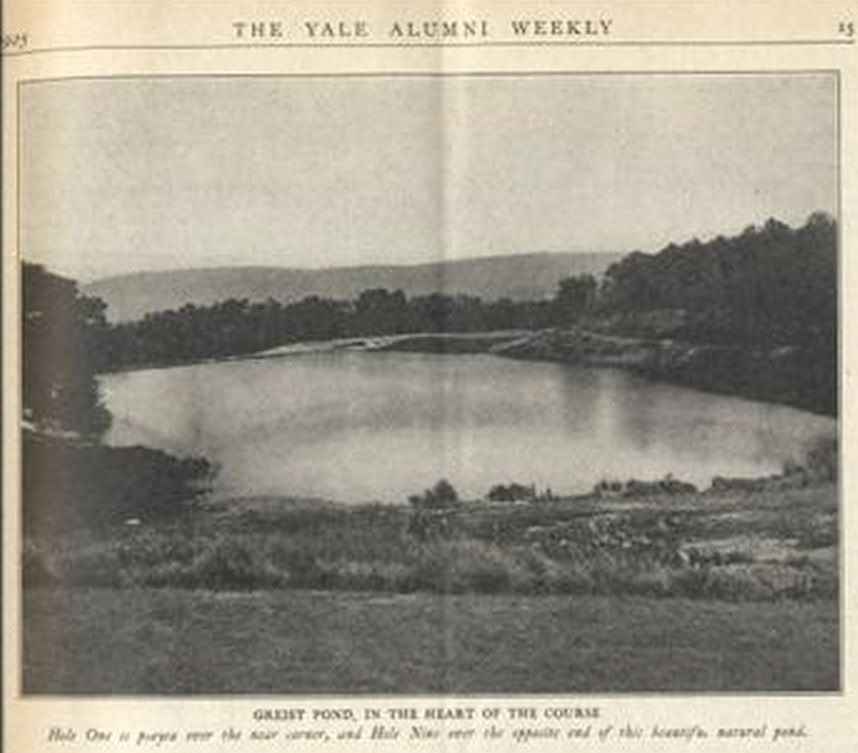 September 30, 1925
September 30, 1925: An un-bylined "Pictorial Supplement" in the
Yale Daily News includes a picture and description of the ninth hole. The description reads, "A DIFFICULT WATER CARRY. Number Nine hole, 225 yards from the back tee, which has its origins on the Biarritz Course in France. This is the second of the short holes, being planned for a single shot to the green with the driver, with a 163-yard water carry from the back tee. From the Regular Course tee the distance is 210 yards and from the Short Course tee is 190 yards. The green is behind a deep trench in the approach, which is about the same size as the green itself and is heavily bunkered on both sides with water jutting in on the right front. The hole is so designed as to cause considerable trouble for either a hooked or a sliced drive." To my eye, the shade of the front and back tiers in the picture looks the same, but the mowing pattern looks different (with the back tier cut like the 18th green in the picture on the right). (By the way, the bunkering looks positively Cypress Point/Friar's Head-esque!)
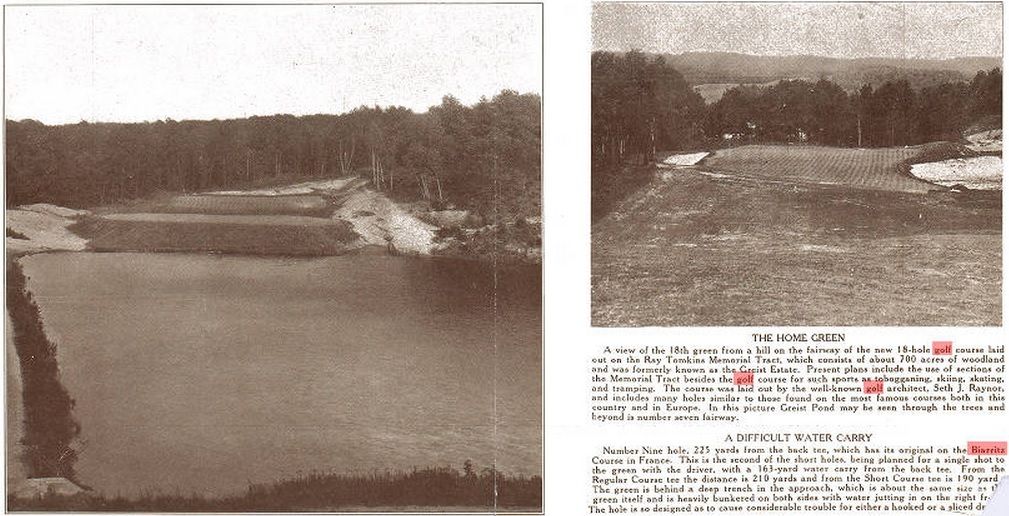 October 29, 1925
October 29, 1925: The
Yale Daily News reports that the course is in "the final stages of completion," with opening set for the following spring. The un-bylined article includes this description of the ninth hole:
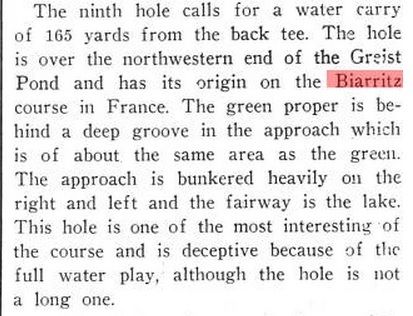 November 19, 1925
November 19, 1925: The
Yale Daily News publishes an un-bylined "Hole-by-Hole Description" of the course, including this description of the ninth hole:
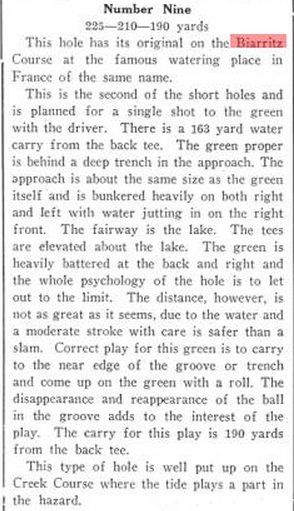 January 22, 1926
January 22, 1926: Seth Raynor passes away from pneumonia in West Palm Beach, Florida. (I recognize that some say he died on January 23 or 24, but the
Brooklyn Daily Eagle's article about his passing is dated January 23 (in the January 24, 1926 print edition) and refers to his having passed away "last night.")
January 31, 1926: Alluding to what could hold the key to this mystery, the
New York Times notes that, "in an elaborate report the committee [the Executive Committee of the Board of Control, as distinct from the Golf Committee] reviewed the work on the course, its finances and every detail from the throwing of the first shovelful of dirt more than a year ago until the present time." That same article notes that "[m]uch work has been done the past Fall and Winter [of 1925-26] under the supervision of William E. Perkins, the superintendent." Unless someone (the microfiche collection at Yale's Beinecke library, perhaps?) has a copy of the Executive Committee's report, perhaps we'll never know the answer. (The online version of "Golf at Yale" has a bibliography with a link to a February 22, 1926 Golf Committee, as opposed to Executive Committee, report, but the link is broken.)
April 15, 1926: According to the
New York Times, the course officially opens, with the first matches played on April 24, 1926. (Apparently, the opening date pertained only to the front nine, as the article notes that the back nine "will be completed by" May 1, 1926.)